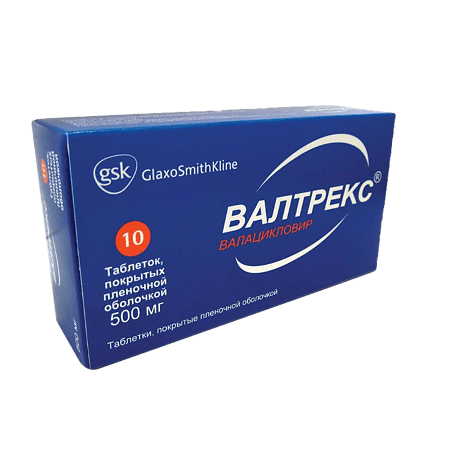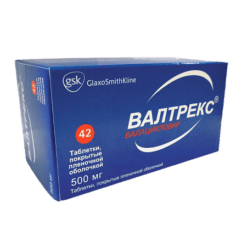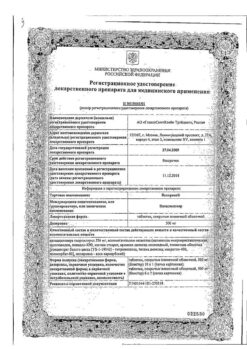No products in the cart.
Description
Pharmgroup:
an antiviral drug.
Pharmic action:
Valtrex is an antiviral drug. In the human body valacyclovir is quickly and completely converted to acyclovir by valacyclovirhydrolase.
Aciclovir in vitro has specific inhibitory activity against Herpes simplex viruses types 1 and 2, Varicella zoster and Epstein-Barr, cytomegalovirus and human herpes virus type 6.
Aciclovir inhibits the synthesis of viral DNA immediately after phosphorylation and transformation into the active form acyclovir triphosphate. The first stage of phosphorylation occurs with the participation of virus-specific enzymes. For Herpes simplex, Varicella zoster and Epstein-Barr viruses, this enzyme is viral thymidine kinase, which is present in virus-affected cells. Partial phosphorylation selectivity is retained in cytomegalovirus and is mediated through the phosphotransferase gene product UL 97. Activation of acyclovir by a specific viral enzyme explains much of its selectivity.
The process of phosphorylation of acyclovir (conversion from mono- to triphosphate) is completed by cellular kinases. Acyclovir triphosphate competitively inhibits viral DNA polymerase and, being a nucleoside analog, is incorporated into viral DNA, which leads to obligate (complete) chain breaking, termination of DNA synthesis and, consequently, to blocking of virus replication.
In immunocompromised patients, Herpes simplex and Varicella zoster viruses with hypersensitivity to Valacyclovir are extremely rare (less than 0.1%), but can sometimes be found in patients with severe immune disorders, such as bone marrow transplants, those receiving chemotherapy for malignancies and those with HIV.
Resistance is caused by a thymidine kinase deficiency in the virus, which leads to excessive spread of the virus in the host. Sometimes decreased sensitivity to acyclovir is due to the emergence of virus strains with disrupted viral thymidine kinase or DNA polymerase structure. The virulence of these varieties of the virus is similar to that of its wild strain.
Pharmacokinetics:
Valacyclovir and acyclovir have similar pharmacokinetic parameters after oral administration.
absorption
Valacyclovir is well absorbed from the gastrointestinal tract after oral administration and is rapidly and almost completely converted to acyclovir and valine. This conversion is catalyzed by the enzyme valacyclovirhydrolase isolated from human liver.
After a single dose of 0.25-2 g of valacyclovir, the Cmax of acyclovir in healthy volunteers with normal renal function averages 10-37 µmol (2.2-8.3 µg/mL) and the median time to reach this concentration is 1-2 hours.
The bioavailability of acyclovir is 54% when valacyclovir is taken at a dose of 1 g or more and is not dependent on food intake.
The Cmax of valacyclovir in plasma is only 4% of the acyclovir concentration and is reached on average 30-100 min after taking the drug; after 3 h the Cmax level remains the same or decreases.
Distribution
The degree of binding of acyclovir to plasma proteins is very low – 15%.
Elimation
In patients with normal renal function the T1/2 of acyclovir is about 3 hours. Valacyclovir is excreted with the urine, mainly as acyclovir (more than 80% of the dose) and its metabolite 9-carboxymethoxymethylguanine, less than 1% of the drug is excreted unchanged.
Pharmacokinetics in special clinical cases
In patients with terminal renal failure the T1/2 of acyclovir is approximately 14 hours.
The pharmacokinetics of valacyclovir and acyclovir are not significantly impaired in patients infected with Herpes simplex and Varicella zoster viruses.
In late pregnancy, the sustained daily AUC after administration of 1 g of valacyclovir was approximately 2 times greater than that of acyclovir at a dose of 1.2 g/day.
The administration of Valtrex in doses of 1 g and 2 g does not impair the distribution and pharmacokinetic parameters of valacyclovir in HIV-infected patients compared to healthy individuals.
In organ transplant recipients receiving Valacyclovir at a dose of 2 g 4 times daily, the Cmax of acyclovir is equal to or greater than that of healthy volunteers receiving the same dose of the drug, and their daily AUCs are significantly higher.
Indications
Indications
– treatment of herpes zoster caused by the Varicella zoster virus (accelerates the disappearance of pain, reduces its duration and the percentage of patients with pain, including acute and postherpetic neuralgia);
– treatment of infections of the skin and mucous membranes caused by the Herpes simplex virus type 1 and 2 (including newly diagnosed and recurrent genital herpes);
– treatment of labial herpes (labial fever);
— Valtrex can prevent the formation of lesions if taken when the first symptoms of a relapse of herpes simplex appear;
– prevention (suppression) of relapses of diseases of the skin and mucous membranes caused by the Herpes simplex virus types 1 and 2, including genital herpes;
— Valtrex may reduce genital herpes infection in a healthy partner if taken as a suppressive therapy in combination with safe sex;
– prevention of cytomegalovirus infection that occurs during organ transplantation (reduces the severity of acute graft rejection in patients with kidney transplants, the development of opportunistic infections and other viral infections caused by Herpes simplex and Varicella zoster viruses).
Pharmacological effect
Pharmacological effect
Pharmgroup:
antiviral agent.
Pharmaceutical action:
Valtrex is an antiviral drug. In the human body, valacyclovir is quickly and completely converted to acyclovir under the influence of valacyclovir hydrolase.
Acyclovir in vitro has specific inhibitory activity against Herpes simplex viruses types 1 and 2, Varicella zoster and Epstein-Barr, cytomegalovirus and human herpes virus type 6.
Acyclovir inhibits viral DNA synthesis immediately after phosphorylation and conversion to the active form of acyclovir triphosphate. The first stage of phosphorylation occurs with the participation of virus-specific enzymes. For Herpes simplex, Varicella zoster and Epstein-Barr viruses, this enzyme is viral thymidine kinase, which is present in cells affected by the virus. Partial phosphorylation selectivity is conserved in cytomegalovirus and is mediated through the phosphotransferase gene product UL 97. Activation of acyclovir by a specific viral enzyme largely explains its selectivity.
The process of phosphorylation of acyclovir (conversion from mono-to triphosphate) is completed by cellular kinases. Acyclovir triphosphate competitively inhibits viral DNA polymerase and, being a nucleoside analogue, is incorporated into viral DNA, which leads to obligate (complete) chain breakage, cessation of DNA synthesis and, consequently, blocking viral replication.
In patients with preserved immunity, Herpes simplex and Varicella zoster viruses with reduced sensitivity to valacyclovir are extremely rare (less than 0.1%), but can sometimes be detected in patients with severe immune disorders, for example, with a bone marrow transplant, in those receiving chemotherapy for malignant neoplasms and in HIV-infected patients.
Resistance is caused by a deficiency of the virus’ thymidine kinase, which leads to excessive spread of the virus in the host. Sometimes a decrease in sensitivity to acyclovir is due to the emergence of virus strains with a violation of the structure of the viral thymidine kinase or DNA polymerase. The virulence of these variants of the virus resembles that of the wild strain.
Pharmacokinetics:
Valacyclovir and acyclovir have similar pharmacokinetic parameters after oral administration.
Suction
After oral administration, valacyclovir is well absorbed from the gastrointestinal tract and is quickly and almost completely converted to acyclovir and valine. This transformation is catalyzed by the enzyme valacyclovir hydrolase, isolated from human liver.
After a single dose of 0.25-2 g of valacyclovir, the Cmax of acyclovir in healthy volunteers with normal renal function averages 10-37 µmol (2.2-8.3 µg/ml), and the median time to reach this concentration is 1-2 hours.
When taking valacyclovir in a dose of 1 g, the bioavailability of acyclovir is 54% and does not depend on food intake.
The Cmax of valacyclovir in plasma is only 4% of the concentration of acyclovir and is achieved on average 30-100 minutes after taking the drug; after 3 hours, the Cmax level remains the same or decreases.
Distribution
The degree of binding of acyclovir to plasma proteins is very low – 15%.
Removal
In patients with normal renal function, T1/2 of acyclovir is approximately 3 hours. Valacyclovir is excreted in the urine, mainly in the form of acyclovir (more than 80% of the dose) and its metabolite 9-carboxymethoxymethylguanine, less than 1% of the drug is excreted unchanged.
Pharmacokinetics in special clinical situations
In patients with end-stage renal failure, T1/2 of acyclovir is approximately 14 hours.
The pharmacokinetics of valacyclovir and acyclovir are not significantly affected in patients infected with Herpes simplex and Varicella zoster viruses.
In late pregnancy, the steady-state daily AUC after taking 1 g of valacyclovir was approximately 2 times greater than that when taking acyclovir at a dose of 1.2 g/day.
Taking Valtrex at a dose of 1 g and 2 g does not affect the distribution and pharmacokinetic parameters of valacyclovir in HIV-infected patients compared to healthy individuals.
In organ transplant recipients receiving valacyclovir at a dose of 2 g 4 times/day, the Cmax of acyclovir is equal to or greater than that in healthy volunteers receiving the same dose of the drug, and their daily AUC values are significantly higher.
Special instructions
Special instructions
Patients at risk of dehydration, especially elderly patients, must ensure adequate hydration of the body during treatment with Valtrex.
Patients with renal failure have an increased risk of developing neurological complications.
In case of liver dysfunction in patients with mild or moderate liver cirrhosis (the synthetic function of the liver is preserved), no dose adjustment of Valtrex is required. When studying pharmacokinetics in patients with severe liver cirrhosis (with impaired synthetic function of the liver and the presence of shunts between the portal system and the general vascular bed), there was also no data indicating the need for correction of the dosage regimen; however, clinical experience with the use of Valtrex in this category of patients is limited.
There is no data on the use of Valtrex in high doses (4 g/day or more) in patients with liver disease, so the drug should be prescribed with caution in high doses to this category of patients.
Elderly patients do not require dose adjustment, except in cases of significant impairment of renal function. It is necessary to maintain adequate water and electrolyte balance.
No special studies have been conducted to study the effect of Valtrex in patients undergoing liver transplantation. However, prophylactic administration of high doses of acyclovir has been shown to reduce cytomegalovirus infection.
Suppressive therapy with Valtrex reduces the risk of transmission of genital herpes, but does not completely eliminate it and does not lead to a complete cure. During therapy with Valtrex, the patient must take measures to ensure the safety of the partner during sexual intercourse.
Use in pediatrics
There is no experience of clinical use of the drug in children.
Impact on the ability to drive vehicles and operate machinery
No special precautions are required.
Active ingredient
Active ingredient
Valaciclovir
Composition
Composition
Valacyclovir (L-valine ester of acyclovir) 500 mg.
Pregnancy
Pregnancy
There are limited data on the use of Valtrex during pregnancy. Valtrex is used only in cases where the potential benefit to the mother outweighs the possible risk to the fetus.
It is recommended to be careful when prescribing Valtrex during lactation.
Contraindications
Contraindications
Hypersensitivity (including to acyclovir).
Side Effects
Side Effects
Adverse reactions are listed below according to the classification by main systems and organs and by frequency of occurrence: very often (≥1/10), often (≥1/100, from the central nervous system: often – headache.
From the digestive system: often – nausea.
Post-marketing data
From the immune system: very rarely – anaphylaxis.
From the side of the central nervous system: rarely – dizziness, confusion, hallucinations, decreased mental abilities; very rarely – agitation, tremor, ataxia, dysarthria, psychotic symptoms, convulsions, encephalopathy, coma.
These reactions are reversible and are usually observed in patients with impaired renal function or against the background of other predisposing conditions. In patients with a transplanted organ receiving Valtrex in high doses (8 g/day) for the prevention of cytomegalovirus infection, neurological reactions develop more often than when taken in lower doses.
From the respiratory system: infrequently – dyspnea.
From the digestive system: rarely – abdominal discomfort, vomiting, diarrhea; very rarely – reversible abnormalities in liver function tests (which are sometimes regarded as manifestations of hepatitis).
From the hematopoietic system: very rarely – leukopenia (mainly observed in patients with reduced immunity), thrombocytopenia.
Dermatological reactions: infrequently – rash, manifestations of photosensitivity; rarely – itching.
Allergic reactions: very rarely – urticaria, angioedema.
From the urinary system: rarely – renal dysfunction; very rarely – acute renal failure, renal colic (may be associated with impaired renal function).
Other: in patients with severely impaired immunity, especially in the late stages of AIDS, receiving valacyclovir in high doses (8 g / day daily) for a long time, cases of renal failure, microangiopathic hemolytic anemia and thrombocytopenia (sometimes in combination) have been observed. Similar adverse reactions have been observed in patients with the same diseases, but not receiving valacyclovir.
Interaction
Interaction
There are no clinically significant interactions between Valtrex and other drugs.
Acyclovir is excreted in the urine mainly unchanged as a result of active tubular secretion. After taking Valtrex at a dose of 1 g, cimetidine and probenecid, which block tubular secretion, increase the AUC of acyclovir and reduce its renal clearance. However, no dose adjustment of Valtrex is required, because acyclovir has a wide therapeutic index.
It is necessary to use Valtrex with caution in higher doses (4 g/day) simultaneously with drugs that compete with acyclovir for the elimination pathway, because there is a risk of increased plasma levels of one or both drugs or their metabolites.
An increase in the AUC of acyclovir and the inactive metabolite mycophenolate mofetil (an immunosuppressant used in transplantation) was observed when these drugs were administered concomitantly.
Caution must be exercised when combining Valtrex in a high dose (4 g/day or higher) with drugs that impair renal function (including cyclosporine, tacrolimus).
Overdose
Overdose
Currently, there is insufficient data on Valtrex overdose.
Symptoms: with a single oral dose of acyclovir in an excessive dose of up to 20 g, partial absorption from the gastrointestinal tract occurred, which was not accompanied by a toxic effect of the drug.
Ingestion of acyclovir in excessive doses for several days was accompanied by gastrointestinal (nausea, vomiting) and neurological symptoms (headache, confusion). Excessive doses of intravenous acyclovir have been associated with increased serum creatinine levels and subsequent development of renal failure, with neurological complications including confusion, hallucinations, agitation, seizures and coma.
Treatment: Patients should be under close medical supervision for signs of toxicity. Hemodialysis significantly enhances the removal of acyclovir from the blood and can be considered the method of choice in the management of patients with an overdose of Valtrex.
Storage conditions
Storage conditions
At a temperature not exceeding 30 °C
Shelf life
Shelf life
3 years
Manufacturer
Manufacturer
Glaxo Wellcome S.A., Spain
Additional information
| Shelf life | 3 years |
|---|---|
| Conditions of storage | At a temperature not exceeding 30 °C |
| Manufacturer | Glaxo Wellcome S.A., Spain |
| Medication form | pills |
| Brand | Glaxo Wellcome S.A. |
Other forms…
Related products
Buy Valtrex, 500 mg 10 pcs with delivery to USA, UK, Europe and over 120 other countries.












